If you're curious about which planet has the most moons, it's Saturn! This gas giant boasts a remarkable total of 145 confirmed moons, surpassing Jupiter, which has 95. Recent discoveries have added to Saturn's moon count, with many smaller moons identified recently. Among its most famous moons are Titan, known for its thick atmosphere and lakes of methane, and Enceladus, famous for its geysers and signs of subsurface water. Learning about Saturn's diverse moon system can be fascinating, so keep exploring to uncover even more intriguing facts and details about our solar system.
Essential Insights
- Saturn currently holds the record for the most moons, with a total of 145 confirmed moons.
- Jupiter follows with 95 officially recognized moons.
- Recent discoveries have added 62 new irregular moons to Saturn's count.
- The largest moons in the solar system, like Titan and Ganymede, are found around Saturn and Jupiter, respectively.
- Future observations may further increase the number of recognized moons around these gas giants.
Saturn's Record Moon Count

Recently, Saturn's moon count skyrocketed to an impressive 145, making it the planet with the most moons in our solar system. This leap in numbers came from the discovery of 62 new moons, all classified as irregular moons. These irregular moons have large, elliptical orbits and various inclinations, indicating they didn't form alongside Saturn but were likely captured by its gravitational pull.
The discovery process was quite advanced, utilizing the "shift and stack" method. By analyzing data from the Canada-France-Hawaii Telescope between 2019 and 2021, researchers could enhance faint signals from these small moons. This technique involves stacking sequential images to reveal objects that would otherwise be undetectable. Enhanced detection techniques played a crucial role in successfully identifying these faint and small moons.
It took years of meticulous work to confirm these new moons, highlighting the complexity of moon formation and observation.
Interestingly, the large number of small moons in retrograde orbits hints at a more dramatic history. Evidence suggests that a moderate-sized moon may have been shattered around 100 million years ago, resulting in the clumped, irregular moons we observe today. These fragments provide vital insights into Saturn's past and the dynamics of its moon system.
With a total of 145 moons, Saturn hasn't only surpassed Jupiter, which has 95, but has also established itself firmly as the planet with the most known moons in our solar system. This record mightn't last long, especially with new observatories set to launch, but for now, Saturn reigns supreme in the lunar count.
Overview of Saturn's Moons
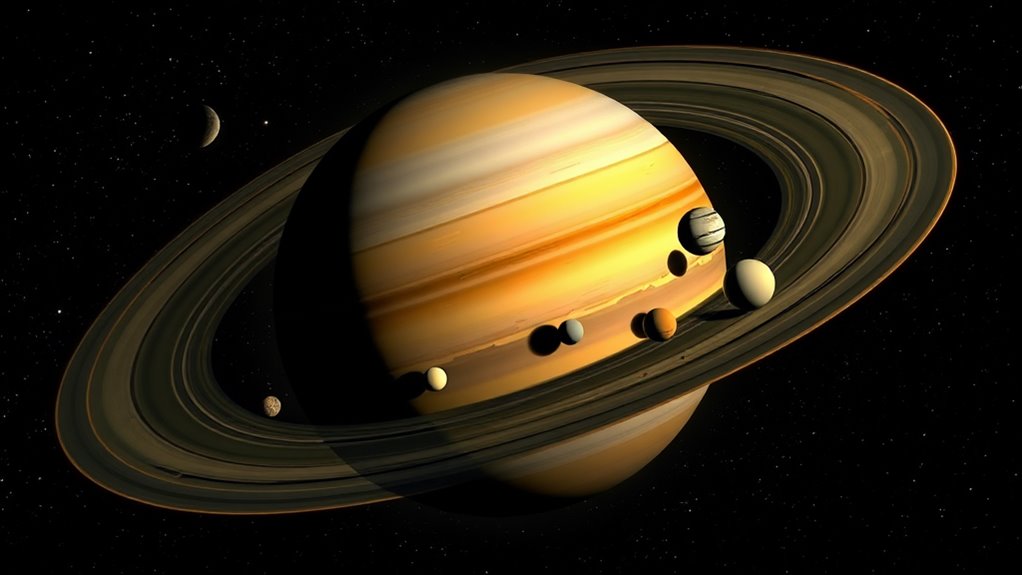
With Saturn now boasting 145 moons, it's fascinating to explore the diversity and characteristics of these celestial bodies. The history of moon discovery around Saturn is rich and intriguing, starting with Galileo's early observations in 1610 and continuing through modern missions like Cassini.
Here's a quick overview of some key aspects of Saturn's moons:
- Titan: The largest moon, featuring a dense atmosphere and lakes of liquid methane.
- Enceladus: Known for its geysers and icy surface, hinting at subsurface water.
- Smaller Moons: Typically rich in ices, they display low densities and varied surface features.
- Orbital Dynamics: Moons interact with Saturn's rings, affecting their orbits and behaviors. Saturn has over 60 known moons, showcasing a vast array of sizes and geological features.
Titan stands out with a diameter of 5,150 km, composed of rocky materials and ices, while Enceladus captivates with its unique water-vapor atmosphere.
The other moons vary greatly in size and composition but often resemble the cratered surface of Earth's moon, influenced by cold ices behaving like rock.
Recent discoveries from the Cassini mission have expanded our understanding of these celestial bodies, revealing intricate dynamics at play among them.
The gravitational effects of larger moons like Titan can dramatically influence the orbits of the smaller moons. Each moon contributes to the rich tapestry of Saturn's moon system, showcasing a variety of moon compositions and unique characteristics that continue to intrigue astronomers and space enthusiasts alike.
Jupiter's Moon Statistics

Jupiter stands as a giant in the solar system, not just for its size but also for its impressive collection of moons. As of now, it boasts 95 officially recognized moons, a number that continues to grow with ongoing moon discovery efforts. In 2021 and 2022 alone, astronomers identified 12 new moons, expanding our understanding of Jupiter's moon dynamics.
These newly found moons vary in size, with most measuring between 0.06 miles and two miles in diameter. Curiously, only about six of them are large enough to earn a name, needing to be at least one mile across.
All of Jupiter's moons are tidally locked, meaning they rotate in sync with their orbits around the planet. This creates a fascinating dynamic where their rotation period matches their orbital period. Many moons have highly elliptical orbits, particularly Io, which experiences significant gravitational variations. Additionally, Jupiter is known for its more than 90 moons, highlighting its status as the planet with the most moons in the solar system.
Most of these moons orbit in a retrograde direction, contributing to their orbital stability. The inner moons, such as Metis and Adrastea, find themselves under immense tidal forces, orbiting within Jupiter's rings. This intense tension suggests they mightn't last long in astronomical terms.
While Ganymede holds the title of the largest moon in the solar system, the unique geological features and volcanic activity of other moons like Io and Europa make them exciting subjects for future research. With new moon discoveries on the horizon, Jupiter's fascinating collection keeps evolving.
The Galilean Satellites
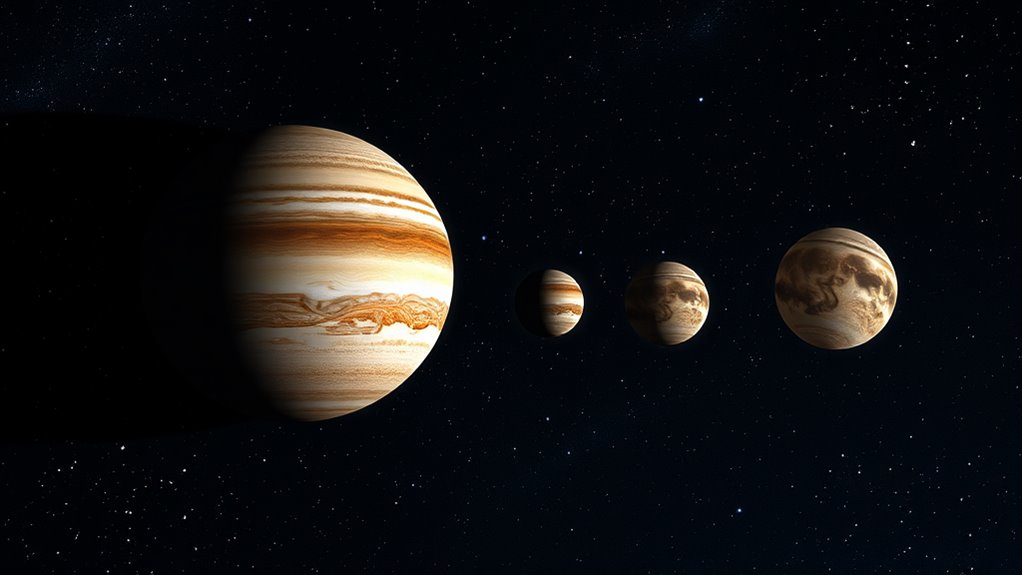
The discovery of the Galilean satellites marked a significant milestone in our understanding of the solar system. On January 7, 1610, Galileo Galilei first observed these moons through his homemade telescope, initially mistaking them for stars. By January 11, he identified them as four distinct moons, which would eventually be named Io, Europa, Ganymede, and Callisto.
This moment in Galilean history not only challenged the geocentric model but also provided astronomical significance that supported the Copernican theory.
These moons exhibit fascinating orbital dynamics and geological diversity:
- Tidal locking: Each moon is tidally locked, always showing the same face to Jupiter.
- Resonance patterns: Io, Europa, and Ganymede are caught in a 1:2:4 resonance, highlighting their synchronized orbits.
- Surface features: Io is known for volcanic activity, while Europa and Ganymede may harbor subsurface oceans. Additionally, Ganymede is the largest moon in the Solar System, making it a particularly noteworthy celestial body.
- Mythological names: The names derive from figures in Greek mythology, enhancing their cultural connection.
The exploration potential of the Galilean satellites is immense. With their unique characteristics, scientists are enthusiastic to study their geology and potential for life, particularly Europa's icy surface and the possibility of an ocean beneath.
Understanding these moons not only enriches our knowledge of the solar system but also emphasizes the intricate synchronicity effects present in their orbits, showcasing the beauty of celestial mechanics.
Characteristics of Jupiter's Moons

Jupiter's moons showcase a remarkable diversity in both physical and orbital characteristics, making them an enchanting subject for study. The four largest moons, known as the Galilean satellites, vary considerably in moon composition and surface geology. Ganymede, the biggest, even exceeds the diameter of Mercury, while Io's surface is a vibrant display of sulfur-based compounds.
When you look at their orbital dynamics, you'll notice a mix of circular and eccentric orbits. Many moons, including some irregular satellites, revolve in retrograde motion, moving against Jupiter's rotation. Tidal forces play an essential role here, influencing how these moons interact with one another and with Jupiter itself. For instance, Io completes its orbit every 1.8 days, creating gravitational interactions that affect Europa and Ganymede through resonances. Additionally, Jupiter has approximately 67 known moons, highlighting the extensive satellite system surrounding the planet.
The discovery history of these moons began with Galileo in 1609, and additional observations continue to reveal exciting findings. Modern telescopes like the Vera C. Rubin Observatory and the Nancy Grace Roman Space Telescope are set to enhance our understanding of these Jovian bodies, particularly the smaller, irregular satellites.
Future explorations promise insights into their size distribution and collisional histories, shedding light on the early Solar System's formation and evolution. As researchers identify more irregular moons, you can expect a deeper comprehension of the complex interplay between Jupiter and its myriad of moons.
Terrestrial Planets and Their Moons
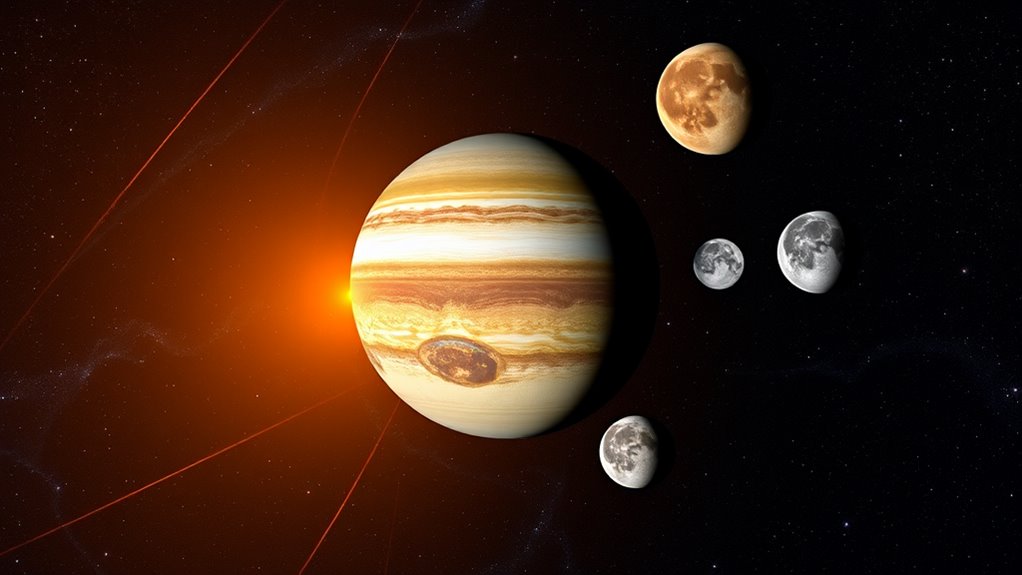
Often overlooked in discussions about moons, terrestrial planets provide a fascinating contrast to their gas giant counterparts. While gas giants boast numerous and diverse moons, terrestrial planets have far fewer, primarily due to their weaker gravitational pull.
As you explore these planets, it's crucial to note their unique lunar characteristics:
- Earth has one moon, known as the Moon or Luna.
- Mars is home to two small moons, Phobos and Deimos.
- Mercury and Venus, however, have no natural satellites.
- The moons of terrestrial planets are generally smaller and less numerous.
The moons comparison between terrestrial and gas giants reveals distinct formation processes. Most terrestrial moons likely formed from discs of gas and dust surrounding their parent planets, while some may have been captured from elsewhere in the solar system. This capture is more common in smaller bodies with weaker gravity, as seen with the total count of moons in the solar system, which is 293.
In terms of orbital and physical characteristics, moons around terrestrial planets typically have solid, rocky surfaces and closer orbits to their parent bodies. Their shorter orbital periods reflect their proximity.
As a result, the interactions between these moons and their planets are more direct and pronounced.
While terrestrial planets may lack the grandeur of gas giants' moon systems, their moons hold significant intrigue. By understanding these differences, you gain a clearer picture of our solar system's complexity and the unique role that terrestrial moons play.
Mercury and Venus: No Moons
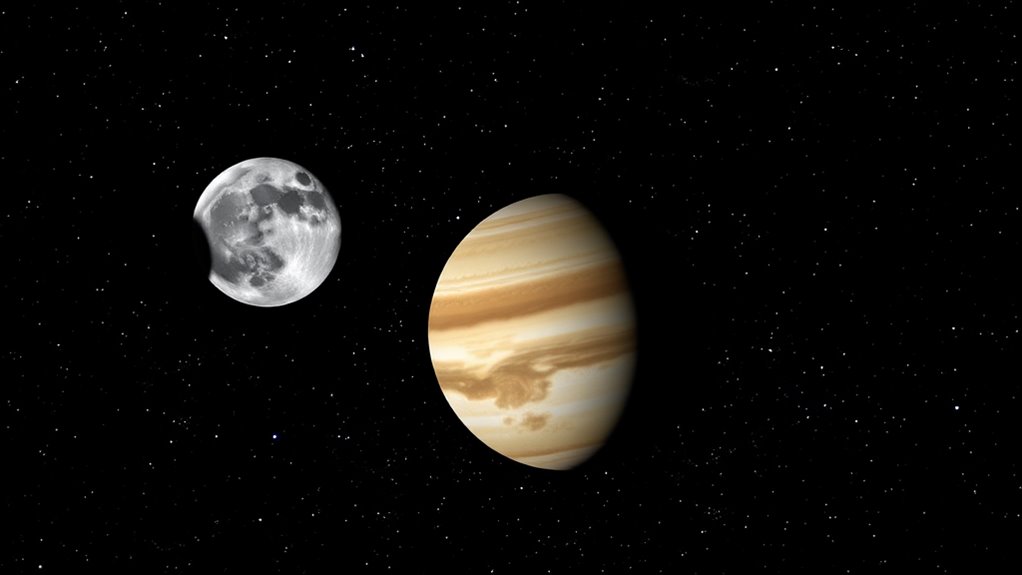
While terrestrial planets like Earth and Mars have their own unique moons, Mercury and Venus stand out because they lack any natural satellites.
Mercury, being the smallest planet in the solar system, has a weak gravitational field. This means it struggles to hold onto any potential moons. Additionally, Mercury's proximity to the Sun creates a strong gravitational pull that overwhelms any moon's ability to maintain a stable orbit. Any moon that might've formed around Mercury would quickly be pulled away by the Sun's gravity.
On the other hand, Venus is considerably larger and has a strong enough gravitational field to retain a moon. However, despite this strength, the Sun's gravitational influence still poses a challenge.
Venus likely had a moon in its past, formed from catastrophic collisions during the early solar system. A second collision reversed Venus's rotation, which played a vital role in the moon's demise. As Venus's rotation changed, the orbital energy of the moon was absorbed by the planet, ultimately leading to the moon's destruction.
Earth's Singular Moon

Earth has one remarkable moon, simply known as the Moon, which plays an essential role in our planet's dynamics. Its gravitational pull influences ocean tides, stabilizes Earth's axial tilt, and contributes to various geological processes.
Measuring about 0.3844 million kilometers from Earth, the Moon's orbit varies between 357,000 km and 407,000 km. With a mass of 0.07346 x 10^24 kg, it's roughly 0.0123 times the mass of Earth.
The Moon's surface features, including the maria and highlands, offer a unique glimpse into lunar geology. The maria, vast dark plains, are rich in iron and titanium, while the highlands consist of lighter, older rocks. The extremely thin atmosphere, with a surface pressure of just 3 x 10^-15 bar, allows for significant temperature fluctuations between day and night.
Moon exploration has been a pivotal part of human curiosity and scientific endeavor. Here are a few key aspects:
- The Giant Impact Theory explains the Moon's formation through a collision with a Mars-sized body.
- The Moon's surface gravity is only about 0.165 times that of Earth, making it a unique environment for exploration.
- Its rocky composition provides insights into the early solar system.
- Ongoing lunar missions continue to unravel its mysteries, aiding our understanding of planetary geology.
As we explore the Moon, we deepen our knowledge of its origins and our place in the cosmos.
Mars and Its Two Moons
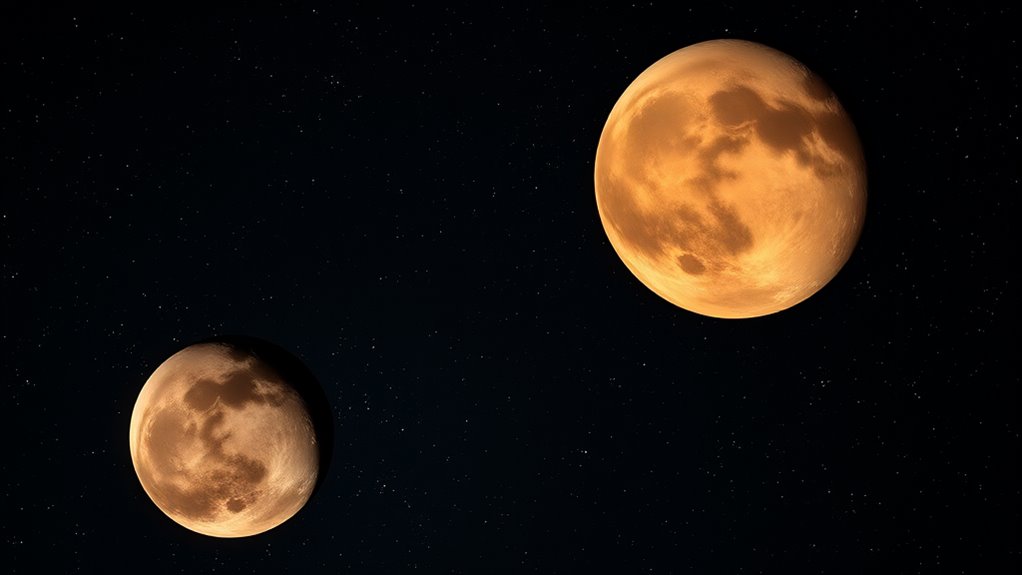
Both moons' origin is a topic of debate.
The leading theory suggests they're captured asteroids from the asteroid belt between Mars and Jupiter, while others speculate they could have formed from debris after a massive impact or even be captured trans-Neptunian objects.
Their unique characteristics make Mars moons a fascinating subject for study.
Uranus's Moon Count

Mars's two moons provide a compelling glimpse into the complexities of celestial bodies, but when it comes to the planet with the most moons, Uranus takes the lead. With a total of 28 confirmed moons, Uranus's moons aren't only numerous but also rich in history and character. You might find it intriguing that many of these moons are named after figures from the works of Shakespeare and Alexander Pope.
Here's a quick look at Uranus's moons:
- First discoveries: Titania and Oberon were discovered by William Herschel in 1787.
- Major moons: The five major moons are Titania, Oberon, Umbriel, Ariel, and Miranda.
- Inner moons: Thirteen inner moons orbit closely within the ring system of Uranus.
- Irregular moons: These moons feature highly inclined and retrograde orbits.
Moon exploration has revealed that the major moons of Uranus are generally spherical, with sizes ranging from 472 km to 1578 km in diameter. Their orbits are primarily prograde, aligning closely with Uranus's equatorial plane.
The inner moons play an essential role in maintaining the planet's ring system, while the irregular moons exhibit fascinating orbital patterns.
Uranus's moons not only enhance our understanding of the planet but also contribute to the broader narrative of moon exploration in our solar system. As you investigate deeper into the mysteries of Uranus, you'll discover a complex and enthralling system of satellites that continue to intrigue astronomers today.
Neptune's Moons Overview

Neptune's moons present a fascinating tapestry of celestial bodies that enrich our understanding of the outer solar system. You'll find that Neptune has 16 known moons, each with unique characteristics and histories.
Triton, the largest moon, was discovered just 17 days after Neptune itself, and its impressive diameter of 2,704 km stands out among its companions. Remarkably, Triton features ice volcanoes that spout liquid nitrogen and methane, creating a dynamic and cold environment that can drop to about -400°F (-240°C).
Triton orbits Neptune in a retrograde direction, hinting at its possible capture rather than formation in place. This retrograde motion may have influenced the eccentric Nereid orbit, which is the most eccentric among Neptune's moons. Nereid's distance from Neptune varies dramatically, being almost seven times farther at one point in its orbit than at another.
The inner moons, like Thalassa and Naiad, exhibit a zigzagging orbital pattern to avoid collisions, demonstrating intricate gravitational interactions.
Some moons were only identified recently, like those discovered using ground-based telescopes in 2002 and 2003. These smaller and darker objects add to the complexity of Neptune's moon system.
Dwarf Planets and Moons
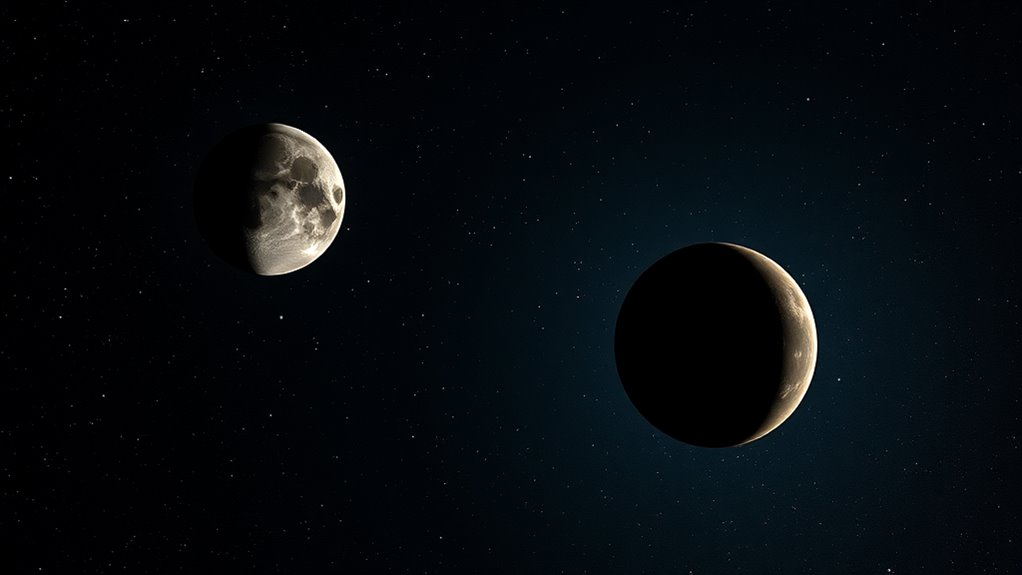
Beyond Neptune's intriguing moons, the dwarf planets in our solar system also host a variety of fascinating moons. These moons exhibit unique dwarf planet characteristics and highlight some interesting moon formation theories.
For instance, Pluto boasts five known moons, with Charon being the most prominent. In fact, Charon is larger than the dwarf planet Ceres and has about 12.2% of Pluto's mass. The gravitational dance between Pluto and Charon results in a tidally locked system, showcasing the complexity of their relationship.
Here's a quick overview of some dwarf planets and their moons:
- Pluto: 5 moons, including Charon.
- Eris: 1 confirmed moon, Dysnomia.
- Haumea: 2 known moons.
- Makemake: 1 known moon.
Moon formation theories suggest that these moons might've formed from collisions between planetary bodies or been captured asteroids. In the early solar system, such collisions were frequent, creating opportunities for moons to form.
Smaller moons around dwarf planets often have chaotic and unpredictable orbits, further emphasizing the dynamic history of these celestial bodies.
Additionally, the presence of moons around these dwarf planets indicates that many experienced significant interactions during their formation. As we explore the dwarf planets and their moons, we gain insight into the complexities of our solar system's history and the forces that shaped it.
Pluto's Moon System
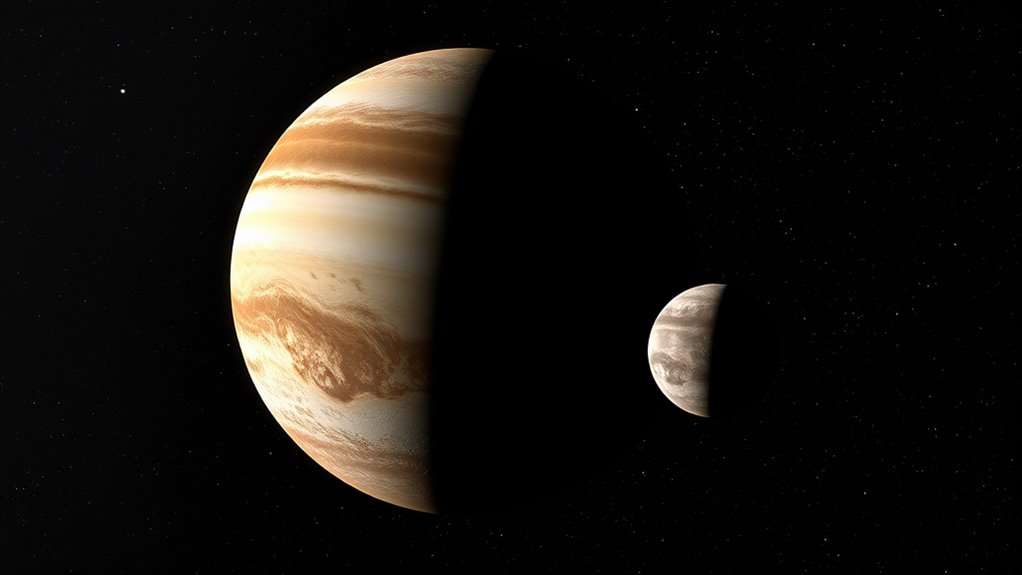
What makes Pluto's moon system so enchanting? With five known moons, this distant celestial family showcases fascinating characteristics and complex orbital dynamics. The largest moon, Charon, isn't just Pluto's companion; it's nearly half the size of Pluto, creating a unique double dwarf planet system where both bodies orbit a shared center of mass outside Pluto's surface.
Here's a quick overview of Pluto's moons:
| Moon Name | Mass (relative to Pluto) | Orbital Distance (Pluto-radii) |
|---|---|---|
| Charon | 12% | 17 |
| Styx | A few millionths | Stable |
| Nix | A few millionths | Stable |
| Kerberos | A few millionths | Stable |
| Hydra | A few millionths | Stable |
Charon's characteristics are remarkable, as it has a mass that considerably influences the gravitational interactions within the system. The smaller moons—Styx, Nix, Kerberos, and Hydra—are also intriguing due to their stable orbits around the Pluto-Charon system rather than Pluto alone.
The circumstantial evidence suggests a complex moon formation history, likely resulting from a giant impact between icy objects. This event created a debris disk from which the smaller moons formed, leading to their current arrangement and stability. Future studies will help clarify the dynamics of this enchanting moon system and the ongoing evolution of Pluto's moons.
Moon Formation and Capture

Understanding the intricate dynamics of moon formation and capture offers a broader perspective on celestial systems like Pluto's. Various theories explain how moons can come into existence, highlighting different processes that shape their origins. You might find the following key concepts intriguing:
- Giant Impact Theory: A Mars-sized body collided with Earth, creating debris that coalesced into the Moon.
- Capture Hypothesis: The Moon may have been captured by Earth's gravity, resulting in its tilted and elliptical orbit.
- Multiple Impacts Model: A series of asteroids striking early Earth formed a debris ring that later merged into the Moon.
- Gravitational Capture: Early in the Solar System, Earth could have captured a passing celestial body through gravitational interactions.
Each theory sheds light on the complexities of moon formation and moon capture. The Giant Impact Theory, for instance, explains why the Moon shares geological similarities with Earth, although discrepancies in composition raise questions.
On the other hand, the Capture Hypothesis suggests that the Moon's orbit deviates from what you'd expect if it formed alongside the Earth.
Understanding these mechanisms helps clarify how moons like Pluto's Charon came to exist. Whether formed through colossal impacts or captured through gravitational interactions, the stories of moons enrich our knowledge of the universe's history and dynamics.
Frequently Asked Questions
How Do Scientists Confirm the Existence of New Moons?
Like Galileo peering through his telescope, you can appreciate the marvel of moon discovery.
Scientists utilize advanced satellite imaging and telescopes to spot new moons, enhancing visibility through a technique known as 'shift and stack.' This method combines sequential images, revealing even faint moons.
Follow-up observations over several years confirm their orbits, ensuring these celestial bodies aren't just stray asteroids, ultimately providing a clearer picture of the moon's existence and characteristics.
What Tools Are Used to Observe Distant Moons?
To observe distant moons, you'll rely on advanced telescopes and satellite missions.
Advanced telescopes, like those proposed for the Moon, enhance sensitivity and allow for detailed observations.
Satellite missions carry specialized instruments that provide unique vantage points, avoiding atmospheric interference.
With tools like astronomical software, you can track moon movements and predict their positions.
Together, these resources help you uncover the mysteries of distant celestial bodies and expand our understanding of the universe.
Can Moons Be Destroyed or Collide With Each Other?
Moons can indeed collide with each other, leading to potential moon destruction.
When moons experience gravitational interactions, their orbits may become unstable, increasing the risk of collisions.
If a moon were to be destroyed, it would require an immense amount of energy, causing debris to rain down on its parent planet.
Such moon collisions or destruction not only reshape the moons themselves but can also have significant consequences for the surrounding environment.
Do Moons Have Atmospheres Like Planets?
Moons can have atmospheres, but they're often quite different from planet atmospheres.
You'll find that some moons, like Titan, boast dense atmospheres, while others, like our Moon, have thin exospheres.
The moon composition plays a big role; volcanic activity or meteorite impacts can create varying atmospheric conditions.
How Do Moons Affect Their Parent Planet's Tides?
Moons considerably influence their parent planet's tides through various tidal effects.
When a moon forms, its gravitational pull creates a tidal range that varies based on its distance from the planet. Closer moons enhance tidal movements, while farther ones reduce them.
If multiple moons exist, their combined gravitational forces lead to complex tidal cycles and periods. This interplay can dramatically shape ocean currents and even impact weather patterns on the planet's surface.
